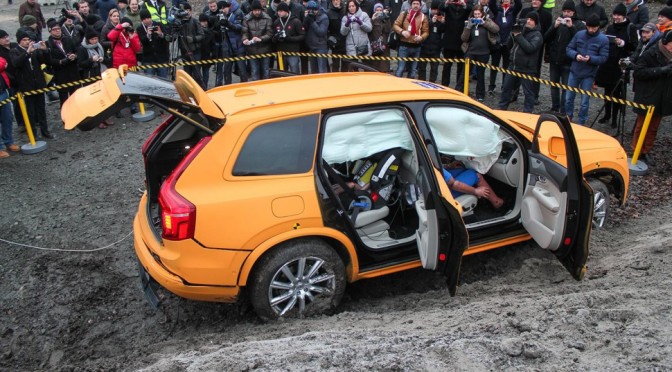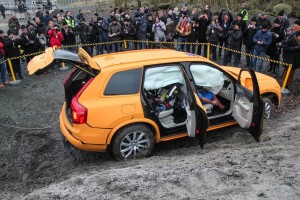 Car manufacturers across the globe are making great strides in auto safety, even though a distressing number of them continue to market sub par products to developing markets (i.e., poor countries). One of the most impressive car manufacturers when it comes to safety has been, and continues to be, Volvo Cars.
Car manufacturers across the globe are making great strides in auto safety, even though a distressing number of them continue to market sub par products to developing markets (i.e., poor countries). One of the most impressive car manufacturers when it comes to safety has been, and continues to be, Volvo Cars.
Makers of the XC90 (3 across car seat guide here), one of the vehicles on the “zero list” on the most recent IIHS driver death rate study, Volvo has seen new life since Ford sold them to Gheely, and are pushing onward with a variety of technologies in effort to promote the safety of their vehicles’ occupants and the pedestrians their vehicles place at risk. I’ve written about their forays into driverless vehicles before, but this article is about an ambitious project of theirs they announced in 2008 demonstrating their commitment to auto safety.
Sustainability and social responsibility, and zero deaths
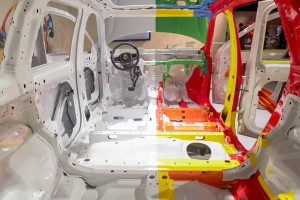 “The goal is unique in that Volvo Cars has designated a year and is showing a social responsibility that also extends to people in other vehicles and pedestrians,” says Anders Eugensson, safety expert at Volvo Cars. ”We are very clear about the fact that our cars should not negatively affect other people at the moment of an accident. In addition, no unprotected roadusers should be seriously injured or killed.”
“The goal is unique in that Volvo Cars has designated a year and is showing a social responsibility that also extends to people in other vehicles and pedestrians,” says Anders Eugensson, safety expert at Volvo Cars. ”We are very clear about the fact that our cars should not negatively affect other people at the moment of an accident. In addition, no unprotected roadusers should be seriously injured or killed.”
This is about as good of a commitment as we can expect from an automaker these days, and it’s a message a number of other auto manufacturers would do well to follow. Social responsibility…sustainability…valuing not only the lives of the people within vehicles but the people outside of them. This is the future. This is what we need more of.
The goal, per Volvo, is that by 2020, or 5 years from now, no occupants in a new (e.g., 2020) Volvo should be killed or seriously injured. This is taking the concept of the zero list and applying it to every passenger vehicle Volvo makes, and also extending the idea to passengers within the vehicle.
Is it possible?
Absolutely. The fact that we have vehicles already starting to show up on zero lists (eight in the last IIHS driver death report and nine in the current DDR) shows it’s possible for drivers in certain vehicles already.
The new generation of the XC90 slated to be released this year is designed to propel Volvo further toward their goal. It’s a lofty one, but it’s one they’ve already achieved on the driver end for the XC90 in the last several years (e.g., 2008-2011 model years). Let’s see what’s inside the new XC90 to help keep the streak going.
The 2016 Volvo XC90’s Safety Features
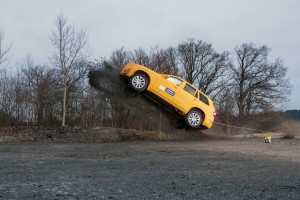 This well-written article in Digital Trends, from where all of these images are sourced, describes some of the features built into the new XC90. One of these is something you’re not going to find tested by any independent agency right now (e.g., the NHTSA or IIHS). It’s a deformable seat system combined with seat belt pretensioners to reduce vertical spinal crush energy from vehicles leaving the road and landing with fatal forces.
This well-written article in Digital Trends, from where all of these images are sourced, describes some of the features built into the new XC90. One of these is something you’re not going to find tested by any independent agency right now (e.g., the NHTSA or IIHS). It’s a deformable seat system combined with seat belt pretensioners to reduce vertical spinal crush energy from vehicles leaving the road and landing with fatal forces.
Volvo looked at their fatalities and injury reports from crashes involving Volvos around the world and decided single vehicle collisions involving road departures were causing too many injuries and taking too many lives. This is exactly what all automakers should be doing–working proactively and not simply reactively. It’s one thing to redesign a vehicle to pass a small overlap test after publically failing it. It’s another thing to look at your internal numbers and design vehicles to pass tests that aren’t even on the books yet.
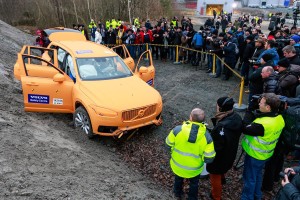 Another example of proactive thinking involves the use of a collapsing brake pedal in the new XC90; the goal is to drop the pedal in a collision to reduce forces on a driver’s leg, since drivers frequently brake in the instants before collisions. Similarly, after the collision, the vehicle automatically engages its brakes to keep from moving into another potentially dangerous situation and further endangering its occupants. That’s forward thinking.
Another example of proactive thinking involves the use of a collapsing brake pedal in the new XC90; the goal is to drop the pedal in a collision to reduce forces on a driver’s leg, since drivers frequently brake in the instants before collisions. Similarly, after the collision, the vehicle automatically engages its brakes to keep from moving into another potentially dangerous situation and further endangering its occupants. That’s forward thinking.
Active safety, Passive Safety
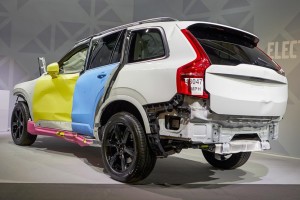
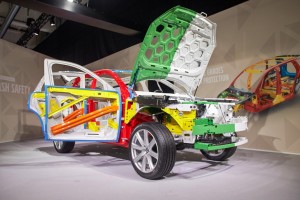
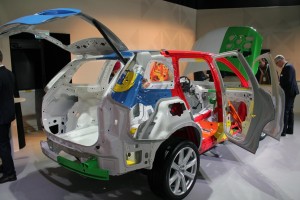 When it comes to car safety, there are many different ways of conceptualizing technologies, and one of the most common involves active safety vs. passive safety.
When it comes to car safety, there are many different ways of conceptualizing technologies, and one of the most common involves active safety vs. passive safety.
Passive safety is crashworthiness; it’s how well your vehicle protects you once a collision has actually occurred. It’s your frame and your airbags and your seat belt and your head restraints and such.
The images to the left that show the color-coded components of the new XC90’s steel structure are examples of passive safety: a strong roof line to protect the occupant cabin in the event of rollovers; side impact beams to offer the same protection during t-bone collisions; energy-absorbing and deflecting structures in the front for full head on, moderate, and small overlap collisions, and so on.
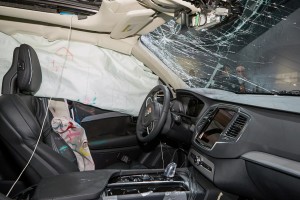 Active safety, however, is where the biggest potential for life-saving technology exists. It’s the ounce of prevention vs. the pound of cure, and it’s the idea behind ABS, ESC (the most significant car safety device since the seat belt), automatic braking systems, and autonomous driving.
Active safety, however, is where the biggest potential for life-saving technology exists. It’s the ounce of prevention vs. the pound of cure, and it’s the idea behind ABS, ESC (the most significant car safety device since the seat belt), automatic braking systems, and autonomous driving.
When it comes to autonomous driving, Volvo’s definitely doing research, but per Peter Mertens, the technology is still very immature.
Peter Mertens, Volvo’s head of R&D, explained that while Volvo is heavily engaged in autonomous driving research, the sort of fully autonomous driving promised by some companies “in the next five years is frankly bullshit.”
To be honest, I don’t agree with him. I do see fully autonomous driving entirely possible within five years, and I see a range of manufacturers heavily invested in making this happen, including Volvo. I’d be happy to see him eat his words, and I suspect he would too, as it would mean safer streets for everyone. But we’ll see. For now, here’s what I believe:
Crash avoidance is the only way to win
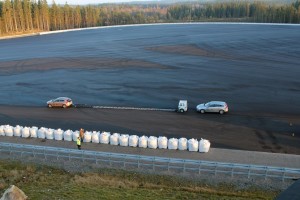 Henrik Ljungqvist, the program manager for body structure, told me that active safety has to dramatically improve. No matter how much ultra high strength steel a carmaker uses, it can’t make a car invulnerable. At least, not when Volvo cars will be sharing the road with 20-ton Volvo trucks.
Henrik Ljungqvist, the program manager for body structure, told me that active safety has to dramatically improve. No matter how much ultra high strength steel a carmaker uses, it can’t make a car invulnerable. At least, not when Volvo cars will be sharing the road with 20-ton Volvo trucks.
Volvo has a lot to accomplish in the next five years if it is to meet its goal … and the engineers know it.
This is the real challenge, because Volvo can’t control the environment its cars are in. But as Volvo’s CEO Hakan Samuelsson explained to me, Vision 2020 is “the only target you can have, you can’t say only fifty people should die in a Volvo; it has to be zero.”
This, to me, is the only bit that truly matters. The article quotes a figure of the XC90 using 38% ultra-high-strength steel in its frame, more than any other passenger vehicle in the industry. But in the end, we’re still fighting physics, and a 4,500 lb vehicle isn’t going to come out better than a 45,000 lb one in a collision between the two even if it’s completely made from high-strength steel.
Similarly, between a 4500 lb XC90 and a 3700 lb S60 or V60, the XC90 will always come out better. Heavier vehicles are always a greater threat to lighter ones, and neither Volvo nor any other manufacturer makes only heavy vehicles. And even if they did, it still wouldn’t bring us as a society closer to a society without auto deaths. Car safety can’t be a zero sum game, where we place other vehicles and occupants at greater risk in order to place others at lower risk.
The only way to win is not to play the game, which means avoiding the collision to begin with. This is where active safety becomes of the utmost importance, and it’s why manufacturers throughout the US, Europe, and parts of Asia are investing money in developing auto-braking and auto-driving technology.
I applaud Samuelsson’s goal of zero, but to achieve it, Volvo will get much farther pursuing crash avoidance and mitigation than they will in pursuing crashworthiness. This is particularly key when we take a larger look at sustainability and focus on reducing the risks all of these massive, heavy, mind-bogglingly fast vehicles place on the most vulnerable among us: those who aren’t in vehicles to begin with.
Each of us is a pedestrian at one point or another, and there are many who are pedestrians because they either cannot afford to or choose not to drive vehicles. There are also children and cyclists to think of, as well as motorcyclists. We deserve as much protection from collisions when we are out of cars as we do when we are in them.
If you find the information on car safety, recommended car seats, and car seat reviews on this car seat blog helpful, you can shop through this Amazon link for any purchases, car seat-related or not. Canadians can shop through this link for Canadian purchases.

